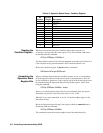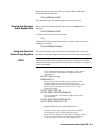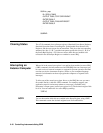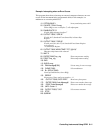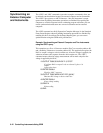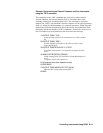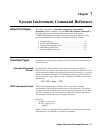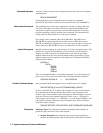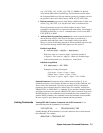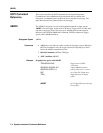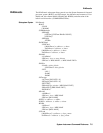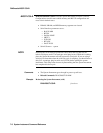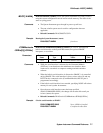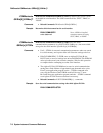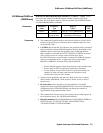Command Separator A colon (:) always separates one command from the next lower level command
as shown below:
ROUTe:SCAN:MODE?
Colons separate the root command from the second level command
(ROUTe:SCAN) and the second level from the third level (SCAN:MODE?).
Abbreviated Commands The command syntax shows most commands as a mixture of upper and lower
case letters. The upper case letters indicate the abbreviated spelling for the
command. For shorter program lines, send the abbreviated form. For better
program readability, you may send the entire command. The instrument will
accept either the abbreviated form or the entire command.
For example, if the command syntax shows MEASure, then MEAS and
MEASURE are both acceptable forms. Other forms of MEASure, such as
MEASU or MEASUR will generate an error. You may use upper or lower case
letters. Therefore, MEASURE, measure, and MeAsUrE are all acceptable.
Implied Commands Implied commands appear in square brackets ([ ]) in the command syntax. (The
brackets are not part of the command, and are not sent to the instrument.)
Suppose you send a second level command but do not send the preceding
implied command. In this case, the instrument assumes you intend to use the
implied command and it responds as if you had sent it. Examine the SOURce
subsystem shown below:
[SOURce:]
PULSe
:COUNt
:COUNt?
:PERiod
:PERiod?
The root command SOURce: is an implied command. To set the instrument’s
pulse count to 25, you can send either of the following command statements:
SOUR:PULS:COUN 25 or PULS:COUN 25
Variable Command Syntax Some commands have what appears to be a variable syntax. For example:
DIAG:INT:SETup[n]? and SYST:COMM:SERial[n]:BAUD?
In these commands, the "n" is replaced by a number. No space is left between
the command and the number because the number is not a parameter. The
number is part of the command syntax. The purpose of this notation is to save a
great deal of space in the command reference. In the case of …SETup[n], n
could range from 1 through 7. In …SERial[n]…, n can be from 0 through 7. You
can send the command without the [n] and a default value will be used by the
instrument. Some examples:
DIAG:INT:SETUP2?, DIAG:INT:PRI2 5, SYST:COMM:SER1:BAUD 9600
Parameters Parameter Types. The following list contains explanations and examples of
parameter types you will see later in this chapter.
• Numeric Parameters are commonly used decimal representations of
numbers including optional signs, decimal points, and scientific notation
7-2 System Instrument Command Reference



